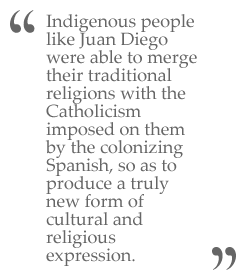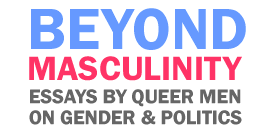|
"…don’t give me your
tenets and your laws. Don’t give me your lukewarm gods.
What I want is an accounting with all three cultures -
white, Mexican, Indian. I want the freedom to carve and
chisel my own face, to staunch the bleeding with ashes,
to fashion my own gods out of my entrails. And if going
home is denied me then I will have to stand and claim my
space, making a new culture - una cultura mestiza
- with my own lumber, my own bricks and mortar and my
own feminist architecture."
- Gloria Anzaldúa,
Borderlands/La Frontera: The New Mestiza [ 1 ]
Queer Mestizaje: Finding
My Own Path
 n
December 9, 1531, on the sacred hill of Tepeyacac, just
outside the recently-conquered city of Tenochitlan/Mexico
City, an indigenous man who is now known only as Juan
Diego combined the traditional Mexica [ 2 ]
goddess Tonantzín with the Spaniards’ Virgin Mary to
create the Virgin of Guadalupe. Juan Diego, a
recent convert to Catholicism, was visited on Tepeyacac
by an oddly brown-skinned Virgin Mary. This seemingly
indigenous Virgin Mary told Juan Diego to visit the
Spanish Bishop in Mexico City and to ask him to build a
church dedicated to her at Tepeyacac. Juan Diego did as
she asked; but the Bishop refused to believe the lowly
indigena (indigenous person) Juan Diego and
demanded proof of this miraculous apparition of the
Mother of God. Juan Diego returned to the sacred hill in
search of proof and found the Virgin Mary waiting for
him. The Virgin Mary instructed him to ascend to the
mountaintop of Tepeyacac where he would find a bounty of
beautiful flowers miraculously growing out of season
that would serve as his proof. Juan Diego gathered the
flowers into his cloak and then descended the holy
mountain to return to the disbelieving Bishop. n
December 9, 1531, on the sacred hill of Tepeyacac, just
outside the recently-conquered city of Tenochitlan/Mexico
City, an indigenous man who is now known only as Juan
Diego combined the traditional Mexica [ 2 ]
goddess Tonantzín with the Spaniards’ Virgin Mary to
create the Virgin of Guadalupe. Juan Diego, a
recent convert to Catholicism, was visited on Tepeyacac
by an oddly brown-skinned Virgin Mary. This seemingly
indigenous Virgin Mary told Juan Diego to visit the
Spanish Bishop in Mexico City and to ask him to build a
church dedicated to her at Tepeyacac. Juan Diego did as
she asked; but the Bishop refused to believe the lowly
indigena (indigenous person) Juan Diego and
demanded proof of this miraculous apparition of the
Mother of God. Juan Diego returned to the sacred hill in
search of proof and found the Virgin Mary waiting for
him. The Virgin Mary instructed him to ascend to the
mountaintop of Tepeyacac where he would find a bounty of
beautiful flowers miraculously growing out of season
that would serve as his proof. Juan Diego gathered the
flowers into his cloak and then descended the holy
mountain to return to the disbelieving Bishop.
Once
again, Juan Diego repeated the Virgin Mary’s request for
the construction of a church at Tepeyacac. The Bishop
again demanded proof. Juan Diego simply replied by
unfurling his cloak and dropping the flowers at the feet
of the Bishop, immediately filling the room with a
tremendous fragrance. It was at that moment that the
Bishop saw the divine imprint of the brown-skinned
Virgin Mary on Juan Diego’s cloak. Being humbled by both
the choice of the indigenous Juan Diego as the Virgin
Mary’s messenger and the brown skin of the Virgin
herself, the Bishop agreed to build the church at
Tepeyacac. [ 3 ]
 The
acceptance of the brown-skinned Virgin Mary on Juan
Diego’s cloak by the Spanish Bishop was the beginning of
the officially-sanctioned cult of the Virgin of
Guadalupe in the Americas. Within the racially-mixed
form of the Virgin of Guadalupe, indigenous people like
Juan Diego were able to merge their traditional
religions with the Catholicism imposed on them by the
colonizing Spanish, so as to produce a truly new form of
cultural and religious expression. Given their inability
to directly confront the more powerful Spanish, the
indigenous peoples of Mexico and Central America used
the Virgin of Guadalupe to create within the dominance
of the Spanish a space of their own. Utilizing the
legitimization that the Spanish Catholic Church
conferred on the Virgin of Guadalupe, indigenas
such as Juan Diego forged religious customs that were
neither Catholic nor the traditional practices of the
Mexica, but that mixed elements from both. The birth of
the brown-skinned Virgin of Guadalupe was a powerful
event that signaled the beginning, first in Mexico and
Central America and then in the United States, of a
process of cultural mixing that has given rise to new
ethnic and national identities. The
acceptance of the brown-skinned Virgin Mary on Juan
Diego’s cloak by the Spanish Bishop was the beginning of
the officially-sanctioned cult of the Virgin of
Guadalupe in the Americas. Within the racially-mixed
form of the Virgin of Guadalupe, indigenous people like
Juan Diego were able to merge their traditional
religions with the Catholicism imposed on them by the
colonizing Spanish, so as to produce a truly new form of
cultural and religious expression. Given their inability
to directly confront the more powerful Spanish, the
indigenous peoples of Mexico and Central America used
the Virgin of Guadalupe to create within the dominance
of the Spanish a space of their own. Utilizing the
legitimization that the Spanish Catholic Church
conferred on the Virgin of Guadalupe, indigenas
such as Juan Diego forged religious customs that were
neither Catholic nor the traditional practices of the
Mexica, but that mixed elements from both. The birth of
the brown-skinned Virgin of Guadalupe was a powerful
event that signaled the beginning, first in Mexico and
Central America and then in the United States, of a
process of cultural mixing that has given rise to new
ethnic and national identities.
The
story of Juan Diego, with its unequal marriage of
conflicted ideas and practices in the face of powerful
forces, is a compelling metaphor for my own life as a
Latino gay man attempting to create a way of being queer
that is ethical, freeing and true to myself. Like Juan
Diego's merging of the repressed indigenous goddess
Tonantzín into the ascendant European Virgin Mary, I
endeavor to create my own gayness through a blending of
two distinct systems of homosexuality: that which my
parents brought with them from El Salvador and that
which I grew into in the United States.
Growing up, my queerness was contained by my family
within the traditional homosexuality of El Salvador. In
that system, homosexuality is a matter of gender
difference that is expressed by both sexual behavior and
deviant gender practices. In El Salvador and much of
Latin America, homosexual men and boys like me are seen
not as women or men but instead occupy an ambiguous
place in between. Under this particular system of
homosexuality, my parents raised me quite differently
from my brothers: I am the only one who was taught by my
mother and grandmother how to cook, clean, sew, and even
now am responsible for organizing family events such as
birthdays, holidays and dinners. As a child, I was
allowed to socialize with girls and women, all without
my gayness being explicitly named. Within my home, my
budding gayness was silently accepted and integrated
into the larger fabric of my family so long as it did
not threaten the heterosexual status quo.
My
family’s acceptance of my gayness was markedly different
from the clearly defined homosexuality of the United
States that I found first on the playgrounds and in the
classrooms of my elementary school, and later on in the
queer identity groups I joined as a teenager. The
homosexuality I found outside of my family was one of a
clearly defined gayness that was accessed through
personal identification. In what I call the American
system of homosexuality, a person was gay either because
they called themselves gay or because others labeled
them that way. As I grew older, I discovered communities
of queer people in the United States built around a
shared sense of identity and personal experience... (continue reading)
|




5 COMMENTS ON THIS ESSAY:
Great essay!Very proud of you for writing this.
GREAT ESSAY!!! good work.
amazing!
i'm so very proud of you, Daniel.
hello daniel
i was wondering, is there maybe a spanish version of your article?
(i would like a spanish/french friend of mine who's lived in latin america for some years to read your piece, and english is difficult for her)
daniel mang
toulouse/france